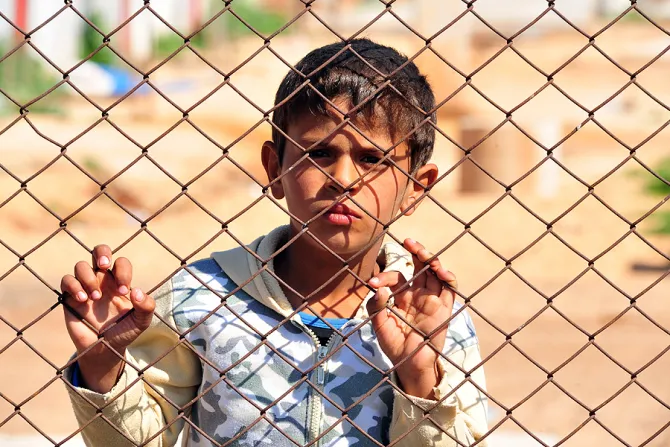Washington D.C., Sep 28, 2017 / 08:55 am
The Trump administration announced on Wednesday it plans to resettle a maximum of 45,000 refugees in 2018, fewer than in 2017 and far fewer than the U.S. accepted in 2016.
The U.S. Conference of Catholic Bishops had proposed earlier this month that 75,000 refugees – which was still a reduction of over 25 percent from the previous administration – be the goal for refugee admission next year.
"We implore the administration to show mercy and compassion for those seeking refuge, and to advance the American value of freedom through providing safe harbor to those fleeing tyranny and religious persecution," the bishops' executive committee stated Sept. 12.
Following reports that the administration was planning to reduce the refugee intake even more in the 2018 fiscal year, the State Department confirmed the number would be smaller on Wednesday.
In President Donald Trump's executive order on immigration signed in March 2017, he ordered a four-month shutdown of refugee resettlement while the program was reviewed. That review period ends Oct. 24. Trump also capped the number of refugees that the U.S. would accept in FY 2017 at 50,000, far below the goal of 110,000 originally set by the Obama administration.
Then on Wednesday, the State Department announced that in its upcoming consultations with Congress it would propose capping refugee admissions at 45,000, including 19,000 from Africa and 17,000 from the Near East and South Asia.
A U.S. government official told reporters on Wednesday that, regarding the new refugee resettlement numbers, "the security and safety of the American people is our chief concern," and that refugee resettlement is "only one part of the United States response to the crisis of forced displacement around the world."
The announcement comes as the number of forcibly displaced persons is at its highest recorded level – over 65 million worldwide, according to the U.N. The number of refugees is also at its highest recorded level at over 22 million.
Caritas Internationalis, a confederation of Catholic aid groups that serve those in need on the ground in countries around the world, began an international "Share the Journey" campaign on Wednesday, inviting Catholics to hear the stories of migrants and refugees, welcome them into their communities, and advocate for policies that would support migrants seeking a better life.
Groups that resettle refugees have said that the resettlement program is secure and that the U.S. maintains stringent vetting of refugees for any potential security threats.
The U.S. Conference of Catholic Bishops has asked that the administration set a goal of resettling 75,000 refugees, saying that to limit the number to "50,000 or below" would be "simply inhumane, particularly when our great nation has the resources and ability to do more."
"We implore the administration to show mercy and compassion for those seeking refuge, and to advance the American value of freedom through providing safe harbor to those fleeing tyranny and religious persecution," the executive committee of the U.S. bishops' conference stated on Sept. 12.
David Robinson, executive director of Jesuit Refugee Service USA stated on Wednesday that the planned number of 45,000 is "shamefully low" and "a retreat from global leadership."
"Our faith calls us to be compassionate, and this unprecedented policy is in direct opposition to the belief that we should welcome the stranger, especially the victims of war, terror and oppression," he said.
The State Department did not notify resettlement groups of the planned 45,000 number, a government official confirmed on Wednesday, saying that "they're well aware of the executive order's number of 50,000 and that I think this is probably in the range that they expected."
Also, the administration does not intend to "slow-roll" the admission so as to resettle only a portion of the goal, an official said. The U.S. could "get into the ballpark of this number" despite the vetting requirements and the need to address a backlog of asylum requests.
(Story continues below)



